Dolce Forte in Renaissance Florentine Cooking

Historical Background
The Renaissance was a period of great cultural and artistic revival in Florence, and this was mirrored in its culinary practices. The Medici family, prominent patrons of the arts and sciences, also had a significant influence on the culinary arts. Banquets during this time were elaborate affairs, and chefs were encouraged to experiment with new flavor combinations and exotic ingredients brought in through Florence’s extensive trade networks.
The dolce forte flavor profile is reflective of the Renaissance interest in balancing opposites. Sweet ingredients were combined with sharp, tangy, and spicy elements to create a harmonious yet striking contrast. This was not only a matter of taste but also an expression of the Renaissance ideals of harmony and balance.
Ingredients and Techniques
Sweet elements:
Vinegar: Provided the necessary acidity to balance the sweetness.
Citrus Juices: Oranges and lemons added a fresh, tangy note.
Capers and Olives: Introduced a salty, briny flavor.
Spices and Nuts:
Cinnamon, Cloves, Nutmeg: These spices, often from distant lands, added warmth and depth.
Almonds and Pine Nuts: Offered a nutty crunch and were often used to garnish dishes.
Example Dishes
Cinghiale in Dolce Forte (Wild Boar in Sweet and Sour Sauce):
This dish involves marinating and slow-cooking wild boar with a sauce made from the aforementioned sweet and sour ingredients. The result is a tender, flavorful meat dish that perfectly encapsulates the dolce forte balance.
Anatra in Dolce Forte (Duck in Sweet and Sour Sauce):
Similar to the wild boar dish, duck is cooked with a rich sauce combining honey, vinegar, raisins, and spices, creating a dish with a luxurious and complex flavor profile.
Modern Adaptations and Significance
While traditional dolce forte dishes are not as common in modern Florence, they are occasionally revived by chefs who seek to honor and experiment with historical recipes. These dishes offer a taste of history and a connection to the culinary traditions of the past.
Modern Interpretations:
Today, you might find dolce forte flavors incorporated into contemporary Italian cuisine, with chefs using the concept to create innovative dishes that balance sweet and savory elements in new and exciting ways.
Sources and Further Reading
For those interested in diving deeper into the history and recipes of dolce forte and other Renaissance dishes, the following sources are invaluable:
"The Florentine Table: Recipes from the Renaissance" - This book offers detailed recipes and historical context, making it a perfect resource for understanding the culinary traditions of Renaissance Florence.
"Medieval Cuisine of the Islamic World: A Concise History with 174 Recipes" by Lilia Zaouali - While focusing on Islamic culinary traditions, this book provides context on how trade and cultural exchanges influenced Renaissance cuisine.
"The Opera of Bartolomeo Scappi (1570): L'arte et prudenza d'un maestro cuoco" - A seminal Renaissance cookbook that provides a glimpse into the cooking techniques and recipes of the period.
Exploring these resources will provide a deeper understanding of the rich and flavorful history of dolce forte in Florentine cuisine.
